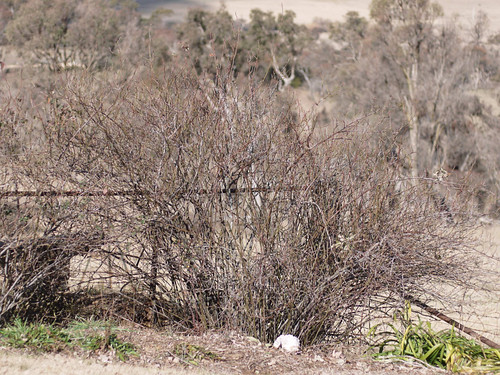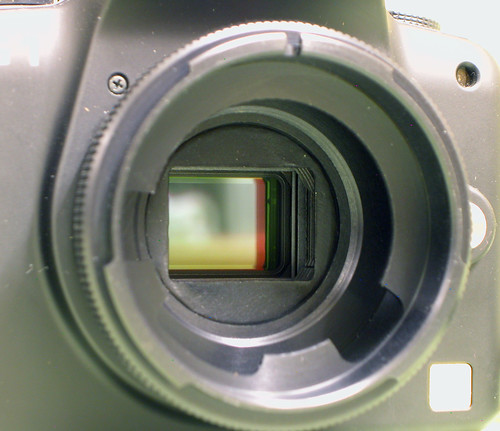As it happens my first adaptor for my G1 was the FD adaptor. The first one was a simple affair which just did the functional job of allowing me to put FD lenses onto my G1. Mounted using this adaptor they could focus and had (manual) aperture control. Don't forget being manual focus lenses they focus manually too ;-)
I wrote a post about that first one here and then wrote about the updated "second series" one here.
the mask
Back some time ago there was a discussion that the Rayqual adaptor had a "mask" in the back of the adaptor to shield the internal of the camera from the extra light that would be falling around when using adapted 35mm lenses.
 If this is a new idea to you, then essentially its about the concept that the image circle of 35mm lenses will be way larger than the 4/3 sensor.
If this is a new idea to you, then essentially its about the concept that the image circle of 35mm lenses will be way larger than the 4/3 sensor.If you look at this diagram I've drawn in blue the tightest circle that a lens can throw and evenly illuminate a 35mm frame / sensor (which I've indicated in blue). As you can see this is way larger than needed for the 4/3 sensor (and a reason why I'm very interested in a tilt adaptor for the 4/3 system as there is plenty of coverage).
Well, so what?
As it happens having all that extra illumination in there has the potential to increase the amount of internal reflection and thus reduce the contrast of the lens by having stray light reflecting around in the area between lens and sensor. Its the reason (incase you never thought of it) that the area behind lenses in SLR cameras is painted black.
I never thought it was an issue, but didn't give it much more thought before that discussion. I wasn't about to pop the bucks for a Rayqual adaptor, so it was essentially a question I could not answer ...
Well, when I saw that Ciecio7 had a new adaptor out which had just such a mask (like the Rayqual one), I asked if he would send me one for evaluation, which he very kindly did.
So I thought I would compare his "series 2" with this new one (should it be the series 3?).
Bottom line early
couldn't see any difference in images, but the adaptor is really nicely made. His stuff gets better every time I see one.
This in itself is a good thing and I personally prefer this adaptor over any other I've tried.
Findings
The first thing which bears a mention is that this new adaptor is not just a series 2 with a mask added. Its subtle but there are other differences. Clearly he's been making a few tweaks to the design.
The first thing I noticed when putting the adaptor onto the lens was that he's snuggled the "grip" area closer to the lens.

which becomes clearer when you compare this to the series 2:

It does make the adaptor look much nicer now.
It helps to cover up the back of the FD lens attachment system (which is normally mounted hard against a camera), this is something I made reference to in my first review of these adaptors. It may be a point of entry for dust, but at that time felt it wasn't anything to get worked up about.
The new adaptor has the alignment dots on the outside and they're nicely placed. The extra dots on the case make it easier to align the adaptor to mount it and the lens. I see that he has now added a youtube video of how to do this on his ebay site so I didn't have to do that one myself.
Anyway, back to the adaptor.
I took a few images using RAW and examined them to see if there was any difference. I used my 28mm and my 50mm lens and took images at f2 and f5.6 to see if there was any effect noticeable as a result of wider angles or aperture. I found nothing different. Here is one sample:
The 50mm test image

And two 100% samples from it. The taking conditions are outside in full sunlight, with the lens well shielded from stray light.
series 2

series 3

I had thought to find some more difference than I did, but I didn't ... so as the old saying goes:
Why is it so...
Well the first thing which comes to my mind is that there is perhaps very little internal bouncing around inside the micro 4/3 "mirror box" in the first place .. probably because there isn't one!
 I mean you can probably go grab your micro 4/3 camera and look, but as you can see here from where the lens or adaptor mounts onto the camera there is only a few mm for light to bounce around in.
I mean you can probably go grab your micro 4/3 camera and look, but as you can see here from where the lens or adaptor mounts onto the camera there is only a few mm for light to bounce around in.There is a nice stepped area around the shutter (reduces reflections) and very little other opportunity between the sensor and the back of the mount.
So if there is to be any light bouncing around in there it will most likely have to be between the back of the FD lens and the inside of the adaptor.
This is where the Ciecio7 adaptor perhaps has an advantage.
The first series of the Ciecio7 and most of the other adaptors use a simple pin to engage the lens's iris engagement pin. However from the second series the Ciecio7 uses a gap in an internal system which is essentially a baffle.
You can see this in the image below (which is one of the images Ciecio7 has on his eBay page)
 Apart from a few gaps to allow lens components in it essentially is a baffle that runs around the interior of the lens.
Apart from a few gaps to allow lens components in it essentially is a baffle that runs around the interior of the lens.Mask (shown here) has far less to do than similar items on the backs of 35mm lenses.

Series 2

Series 3

So looking at them like this it seems that there really isn't much for the "mask" do to in cutting down on internal reflections ... is there?
So, what's the advantage? should you buy the new one?
If you already have the series 2, then probably no. If you don't have an FD adaptor or are after another one, then this adaptor is one of the best made you can get on the market for any price. Compared to many other adaptors its carved from a single billet of alloy and you won't be getting any issues of screws being or coming lose (as I had on the RJ Camera one).
The construction of this adaptor is excellent. The sample I had fitted all my FD lenses perfectly and infinity focus was spot on with 28mm and 50mm lenses (length is more critical with the shorter focal length lens).
Another advantage is that the price of this new adaptor is slightly less than I paid for the series 1 adaptor. The seller is actually the maker (as I understood things) and so you're not just buying something from on-seller. As I've stated on my blog before, I'm a big fan of the free market and supporting that with information to help that along. So like Adam Smith wrote:
By pursuing his own interest he frequently promotes that of the society more effectually than when he really intends to promote it.
So buying a well made product that does the job well at a good price (way lower than a Rayqual) you not only get a better bit of gear, you essentially vote for a business who was among the first to make this kind of product, but also one of the few who keeps trying to make it better (unlike many of the el cheapo eBay sellers).
:-)
The mask is certainly not hurting anything.











5 comments:
In my experience a lens hood is more efficient in improving the performance of a lens. Especially for fast glass with large front elements. I got myself a BT-52 hood for the Canon FD 50mm f/1.2L I own. The hood is originally for a 100mm lens, but mounted on a 2x crop camera it has just the optimum depth.
The difference in contrast achieved at f/1.2 is quite striking.
agreed ... but it is at least interesting to explore if this change has any effect (as has been claimed by some).
There might be an interesting twist to this baffle. I recently got to know that there is a "AF confirmation" chip available now for µFT which sort of facilitates the use of legacy, manual focus lenses. It is claimed to enable "focus lock confirmation" for any manual focus lens and is to be mounted inside the lens adapter. I have ordered one, just because I'm curious. It did not arrive yet (shipping from Shanghai takes some time), but reading the mounting instructions you have to glue it inside the adapter somehow. The baffle on this adapter might prevent that, or maybe it makes it even easier.
For now it is however unproven whether this chip does what it claims to do. I'll blog as soon as I have it in my hands.
jmr
did you watch the video linked to above? I know that lens twists a locking ring and the later FD lenses twist the entire lens, but its essentially the same.
If you have that same adaptor (and not a copy by another maker) then just follow the video carefully and watch exactly where the dots are.
Compared to mounting FD lens on a FD camera the adaptor mounting can be a little confusing at first.
Pay attention also to feeling the slight spring tension as the adaptor pulls the aperture ring (also demonstrated in the video).
glad I could help.
I've got a GH-1 now and sold the G1 ... feel a little like bad in selling the G1 but can't justify keeping it for 'old times sake'
:-)
Post a Comment